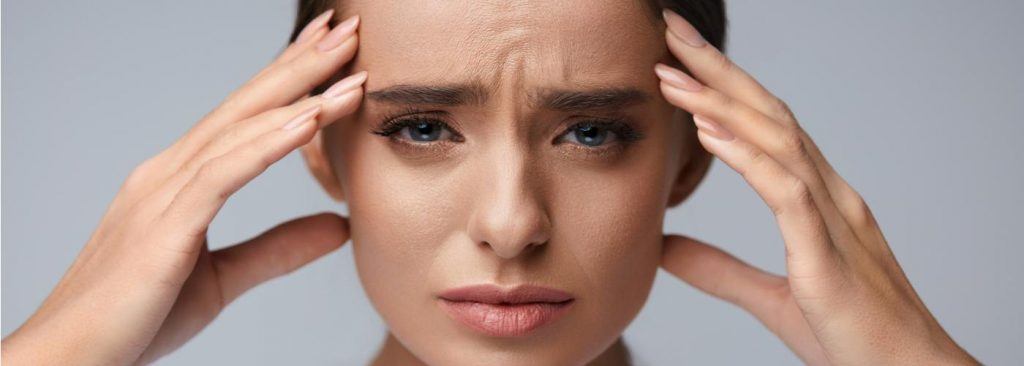Everyone at some point has experienced a conventional headache, and usually the solution is take some aspirin. Some people, however, have incessant, tiring migraines. There are treatment options for people experiencing these complications. Chronic migraines are actually very common. The Migraine Research Foundation states that almost 40 million Americans experience migraines.¹ Here, we have put together a list of symptoms and the treatment options that a migraine victim has at their disposal.

How can one distinguish between intense headaches and migraines? Anyone that has intense headaches could in reality have chronic migraines. To understand the difference between the two, we’ve laid out the symptoms below.
Migraine Symptoms
One major thing that distinguishes the conventional headaches from a migraine attack is that the latter causes serious, uninmaginable pain. Migraine attacks also have symptoms such as nausea and vision disturbances where the victiom may see stars, zigzagging lines, or shimmering lights. There are also cases of extreme migraine attacks where the victim is bed-ridden for some time.
According to the Migraine Trust, there are four main migraine attack stages, and each stage has its distinctive symptoms:
1. Prodrome Stage
The prodrome stage is the stage where one can tell if they are about to have a migraine. This stage lasts up to 24 hours before the migraine hits. Some of the symptoms are mood changes, sweet food cravings, fatigue, thirst, and a stiff neck. Once a person experiences any of these symptoms or has that feeling that a migraine attack is on the way, take action immediately to avert the more intense attack that is sure to come.
2. Aura Stage
A person under a migraine attack may not experience this stage. Usually, the aura comes right before the main attack and can last up to 60 minutes. Some recognizable symptoms of the aura stage include seeing flashing or shimmering lights, stars, dark spots, or colored spots. Other symptoms that are probable during this stage are: Dizziness, tingling, numbness, and weakness, along with speech and hearing issues.
For anyone who has ever experienced an aura before, this stage of a migraine can be very terrifying. The recommended thing to do is to stay calm, treat the symptoms as soon as possible, and understand that it will eventually pass.
3. Attack Stage
Anyone who gets to this stage has gotten to the main stage of any migraine. Symptoms at this stage include serious, throbbing, and often unbearable pain on one or both sides at the same time. A person may also experience pains at their forehead, but reports about pains in the back of the head are not uncommon. Other possible symptoms are: nausea, and a sensitivity to light, touch, and sound.
What a person can do at this stage, if possible, is to find a dark and quiet place to take as much rest as possible until the pain subsides.
4. Postdrome Stage
The postdrome stage tends to give that feeling similar to a hangover, and it lasts for hours or days with symptoms similar to the prodrome stage. The recommended thing to do at this stage is to take some time to relax and recover. There is no set time; take as much time as possible.
Migraine Medication
To combat migraines, there are two types of medications according to the Mayo Clinic. These are: prophylactic medication and pain relievers. Pain relievers such as aspirin, ibuprofen, and acetaminophen don’t usually require a prescription but they’re for less serious cases.²
For more serious cases, a doctor might prescribe triptan medications that constrict blood vessels and interfere with pain pathways. Another type of medication usually prescribed are ergots, which are a combo of ergotamine and caffeine. Moreover, there are opioids which are reserved for extreme cases, and glucocorticoids to boost other pain reliever medications.
For people who experience repeated migraine attacks for 12 hours or more with extended aura stages, prophylactic treatment is probably the suitable option. This group of medications includes beta-blockers for high blood pressure and anti-seizure prescriptions to reduce the number of attacks. Lastly, quarterly botox injections could also ease symptoms and attacks.
Alternative Migraine Treatment Options
Moving away from conventional medicine, there are many lifestyle changes and non-traditional treatments that one may be interested in, such as:
-Yoga
-BioFeedBack
-Massage Therapy
-Cognitive Behavioural Therapy
-Acupuncture
Moreover, the American Migraine Foundation recommends avoiding trigger foods such as chocolate or liquor, and eating more healthy foods, vegetables, and fruits instead of processed food and red meats.³ Quitting smoking and regular exercise is also highly recommended.
Anyone Can Find A Migraine Treatment Plan
To start fighting chronic migraines, the first step is to take note of one’s symptoms, triggers, and the length of attacks to help doctors get the right diagnosis and treatment. Before a visit to the doctor, get on the internet and do some research, compare available options. After doing this, one can then see a qualified specialist.
Sources:
[1] “Raising Money for Migraine Research.” Migraine Research Foundation. https://migraineresearchfoundation.org/about-migraine/migraine-facts/
[2] “Migraine.” Mayo Clinic. https://www.mayoclinic.org/diseases-conditions/migraine-headache/diagnosis-treatment/drc-20360207
[3] Rashmi Halker et al. “Migraine and Diet.” American Migraine Foundation, 1 January 2016. https://americanmigrainefoundation.org/resource-library/migraine-and-diet/


